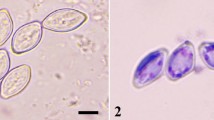Abstract
The identity and activity of an entomopathogenic fungus belonging to the Entomophthora muscae species complex and infecting Musca domestica in poultry houses from La Plata, Argentina, is reported. Entomophthora caused natural infections between September 2001 and September 2003. Primary conidia of this fungus were on average 29.5 ± 1.2 × 23.4 ± 2.4 µm and contained, on average, 10.5 ± 0.1 nuclei (range: 7–15) with an average diameter of 4.8 ± 0.1 µm. This fungus is identified as E. ferdinandii Keller (this specific epithet includes a nomenclaturally required spelling correction); this is a first record of E. ferdinandii in South America and of any member of the E. muscae species complex from flies in Argentina.
Similar content being viewed by others
References
DM MacLeod E Müller-Kögler N Wilding (1976) ArticleTitleEntomophthora species with E. muscae-like conidia Mycologia 68 1–29 Occurrence Handle1:STN:280:CSmB38%2Fitlc%3D Occurrence Handle934179
Jensen AB. Taxonomy, Biology and Ecology from the entomopathogenic genus Entomophthora. Ph.D. Thesis, Department of Ecology, The Royal Veterinary and Agricultural University, Copenhagen, Denmark, 2001.
AB Jensen J Eilenberg (2001) ArticleTitleGenetic variation within the insect-pathogenic genus Entomophthora focusing on the E. muscae complex, using PCR-RFLP of the IST II and the LSU r DNA Mycol Res 105 307–312 Occurrence Handle10.1017/S0953756201003434 Occurrence Handle1:CAS:528:DC%2BD3MXktVOmt70%3D
T Steenberg KM Jespersen V Jensen BO Nielsen RA Humber (2001) ArticleTitleEntomopathogenic fungi in flies associated with pastured cattle in Denmark J Invertebr Pathol 77 186–197 Occurrence Handle1:STN:280:DC%2BD3M3msVKisw%3D%3D Occurrence Handle11356054
CM Aruta R Carrillo JA Montealegre (1984) ArticleTitleDeterminación para Chile de hongos del orden Entomophthorales AgroSur 12 36–42
G Madeira (1998) ArticleTitlePersistence of conidia of Entomophthora muscae in relation to age, temperature and humidity BioControl 43 87–95 Occurrence Handle10.1023/A:1009905800396
RA Humber (1989) ArticleTitleSynopsis for a revised classification for the Entomophthorales (Zygomycotina) Mycotaxon 24 441–460
Humber RA. Systematics and taxonomic approaches to entomophthoralean species. Proceedings and Abstracts 5th International Colloquium on Invertebrate Pathology and Microbial Control Adelaide, Australia, August 20–24, 1990, pp. 133–137.
S Keller (1984) ArticleTitleEntomophthora muscae als Artencomplex Mitt Schweiz Entom Ges 57 131–132
S Keller (1987) ArticleTitleArthropod-pathogenic Entomophthorales of Switzerland I. Conidiobolus, Entomophaga and Entomophthora Sydowia Ann Mycol 43 39–122
S Keller (2002) ArticleTitleThe genus Entomophthora (Zygomycetes: Entomophthorales) with a description of five new species Sydowia 54 157–197
S Keller V Kalsbeek J Eilenberg (1999) ArticleTitleRedescription of Entomophthora muscae (Cohn) Fresenius Sydowia 51 197–209
A Beauvais JP Latgé (1988) ArticleTitleA simple medium for growing entomophthoralean protoplasts J Invertebr Pathol 51 175–178
JP Kramer DC Steinkraus (1981) ArticleTitleCulture of Entomophthora muscae in vivo and its infectivity for six species of muscoid flies Mycopathologia 76 139–143 Occurrence Handle10.1007/BF00437194
L Thomsen J Eilenberg (2000) ArticleTitleEntomophthora muscae resting spore formation in vivo in the host Delia radicum J Invertebr Pathol 76 127–130 Occurrence Handle1:STN:280:DC%2BD3cvnvVeqsQ%3D%3D Occurrence Handle11023736
L Thomsen J Bresciani J Eilenberg (2001) ArticleTitleFormation and germination of resting spores by different strains from the Entomophthora muscae complex in Musca domestica Can J Bot 79 1076–1082 Occurrence Handle10.1139/cjb-79-9-1076
W Greuter J McNeill FR Barrie HM Burdet V Demoulin TS Filgueiras DH Nicholson PC Silva JE Skog P Trehane NJ Turland DL Hawksworth (2000) International Code of Botanical Nomenclature (Saint Louis code) Koeltz Scientific Books Königstein
InstitutionalAuthorNameHumber (1976) ArticleTitleThe systematics of the genus Strongwellsea (Zygomycetes: Entomophthorales) Mycologia 68 1042–1060 Occurrence Handle1:STN:280:CSiD2MnhslE%3D Occurrence Handle1033459
Author information
Authors and Affiliations
Rights and permissions
About this article
Cite this article
Lastra, C.C.L., Siri, A., García, J.J. et al. Entomophthora ferdinandii (Zygomycetes: Entomophthorales) Causing Natural Infections of Musca domestica (Diptera: Muscidae) in Argentina. Mycopathologia 161, 251–254 (2006). https://doi.org/10.1007/s11046-005-0248-2
Received:
Accepted:
Issue Date:
DOI: https://doi.org/10.1007/s11046-005-0248-2




